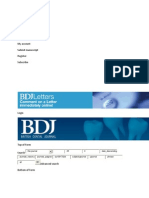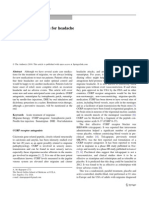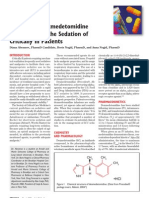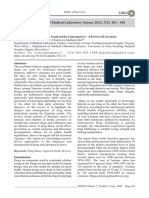PCM Vs Tramadol
PCM Vs Tramadol
Uploaded by
Ummi FakhiraCopyright:
Available Formats
PCM Vs Tramadol
PCM Vs Tramadol
Uploaded by
Ummi FakhiraOriginal Title
Copyright
Available Formats
Share this document
Did you find this document useful?
Is this content inappropriate?
Copyright:
Available Formats
PCM Vs Tramadol
PCM Vs Tramadol
Uploaded by
Ummi FakhiraCopyright:
Available Formats
Abstract Background Tramadol is increasingly used for the treatment of osteoarthritis because, in contrast to nonsteroidal anti-inflammatory drugs (NSAIDs),
tramadol does not produce gastrointestinal bleeding or renal problems, and does not affect articular cartilage. Objectives We sought to determine the analgesic effectiveness, the effect on physical function, the duration of benefit and the safety of oral tramadol in people with osteoarthritis. Search strategy We searched the Cochrane Central Register of Controlled Trials (CENTRAL), MEDLINE, EMBASE and LILACS databases up to August 2005. Selection criteria We included randomized controlled trials (RCTs) that evaluated the effect of tramadol or tramadol plus paracetamol on pain levels and/or physical function in people with osteoarthritis. No language restriction was applied. Data collection and analysis We analyzed separately placebo-controlled and active-controlled studies. We used fixed-effect models for the metaanalyses as the results across studies were similar. Main results We included eleven RCTs with a total of 1019 participants who received tramadol or tramadol/paracetamol and 920 participants who received placebo or active-control. The placebo-controlled studies indicated that participants who received tram adol had less pain (-8.5 units on a 0 to 100 scale; 95% confidence interval (CI) -12.0 to -5.0) than patients who received placebo. This represents a 12% relative decrease in pain intensity from baseline. Participants who received tramadol had a 37% increase (95% CI 1.2 to 1.5) in the likelihood of reporting moderate improvement (number needed to treat to benefit = 6; 95% CI 4 to 9). Participants who received tramadol had 2.27 times the risk of developing minor adverse events and 2.6 times the risk of developing major adverse events, compared to participants who received placebo. Of every eight people who receive tramadol or tramadol/paracetamol, one will stop taking the medication because of adverse events, number needed to treat to harm (NNTH)= 8 (95% CI 7 to 12) for major adverse events. No conclusion could be drawn on how tramadol or tramadol/paracetamol compared with available pharmacological treatments because of the limited number of studies that evaluated such therapies. Authors' conclusions Tramadol or tramadol/paracetamol decreases pain intensity, produces symptom relief and improves function, but these benefits are small. Adverse events, although reversible and not life threatening, often cause participants to stop taking the medication and could limit tramadol or tramadol plus paracetamol usefulness.
Propacetamol vs. Tramadol for postoperative pain management after urologic surgery Aghamir SK1, Mojtahedzadeh M2, Alizadeh F3 , Khalili H4, Sadeghi M5, Najafi A5, Rezaie K6, Rafizadeh F6, Shabani F6 1MD. Assistant Professor. Department of Urology. SINA Hospital. Tehran University of Medical Sciences 2Pharm D, BCPS. Associated Professor. Department of Pharmacotherapy. SINA Hospital. Tehran University of Medical Sciences 3MD. Department of Urology. SINA Hospital. Tehran University of Medical Sciences 4Pharm D. Department of Pharmacotherapy. Faculty of Pharmacy. Tehran University of Medical Sciences 5MD. Department of Anesthesiology. SINA Hospital. Tehran University of Medical Sciences 6-Intensive Care Nurse. SINA Hospital. Tehran University of Medical Sciences Correspondence: Hossein Khalili, Department of Pharmacotherapy, Tehran University of Medical Sciences, Tehran,IRAN
Abstract Paracetamol (acetaminophen) is a safe and effective analgesic that is used for relieving mild to moderate pain. Tramadol, a synthetic opioid of aminocyctohexanol group, is an analgesic with central effect and weak opioid agonistic properties. This drug is also effective on noradrenergic and serotonergic neurotransmission. The aim of this study was to compare the analgesic and side effects of Propacetamol (Prodafalgan,UPSA, France) and Tramadol (Aburaihan Pharmaceutical, Iran) after urologic open surgeries. A total number of 40 surgical patients were prospectively randomized into two equal groups of 20 and were entered into single blinded clinical trial. Anesthesia protocol was similar for all patients. Pain intensity was measured based on a 4point verbal rating scale (VRS). VRS was obtained before analgesic administration (T0) and at 0.5, 1.5, 3, 4.5, 6, 12, 18 and 24 hours. Patients received either Tramadol 100 mg IV or Propacetamol 2 gr IV at T0 and then 50 mg Tramadol or 1.5 gr Propacetamol at 6, 12, 18 and 24 hours if pain was present. Pain relief score was measured after 24 hours based on a 5 point scale. The results of this study showed that Propacetamol could be considered as a safe alternative post-operatively for pain management; however its use for severe pain management leads to inefficient pain control, necessitating supplementary analgesics. Keywords: Propacetamol, Tramadol, Analgesia
Introduction Paracetamol (acetaminophen) is a safe and effective analgesic that is used for relieving mild to moderate pain (1). Oral and rectal formulations of this drug are used as adjunct parts of balanced analgesic regimens peri operatively (2-4). Propacetamol is the watersoluble prodrug of paracetamol that can be used if increased efficacy or more rapid onset of action is desired. In the blood, this drug is easily broken to paracetamol and diethylglycin under the effect of plasma esterases (5). Each gram of Propacetamol is there for equal to 0.5 gram of paracetamol. The latter substance then passes the blood brain barrier easily, exerting its central analgesic effect (6-7). The tolerability of Propacetamol is almost similar to that of paracetamol. Acetaminophen, however, is most effective for mild to moderate pain. On the other hand, the use of opioids may some times be limited because of the concern regarding their side effects, especially respiratory depression. In this situation, Tramadol could be a suitable alternative. Tramadol, a synthetic opioid of aminocyctohexanol group, is an analgesic with central effect and weak opioid agonistic properties. This drug is also effective on noradrenergic and serotonergic neurotransmission (8). When administered intravenously, Tramadol has a potency which is equal to pethidine and 1/10 of morphine (9). In patients older than 1 year it is tolerated well and has no remarkable adverse effect on hemodynamic and respiratory profiles (10). The aim of this study was to compare the analgesic effect and side effects of Propacetamol (Prodafalgan,UPSA, France) and Tramadol (Aburaihan Pharmaceutical, Iran) after urologic open surgeries.
Material and methods A total number of 40 patients were prospectively randomized into two equal groups of 20 and were entered into this singles blinded clinical trial. The study was approved by investigational review board at Tehran University of Medical Sciences. All the patients were informed about the trial, however they did not know which analgesic have been prescribed for them. Inclusion criteria were age > 18 years, postoperative pain, uncomplicated anesthesia, ASA class I or II, consciousness which was required for co-operation and open urologic surgery with either abdominal or flank incision including open prostatectomy, RPLND, radical cystectomy, pyelolithotomy, pyeloplasty, nephrectomy and nephrolithotomy. Exclusion criteria were pregnancy or lactation, drug or alcohol abuse, known allergy to Tramadol or acetaminophen or any contraindications for opioids use, history of renal, hepatic or pulmonary disease, hemorrhagic disorders and taking monoamine oxidase inhibitors or discontinuation of their use within the previous 2 weeks. Anesthesia protocol was similar for all patients consisting of 1) metoclopramide 10 mg IV, 2) fentanyl 1 mg/kg IV, 3) atropine 0.6 mg IV as required to maintain heart rate above 50 beats/min 4) propofol 2.5 mg/kg IV 5) atracurium 0.6 mg/kg followed by 0.3 mg/kg increments as necessary 6) oxygen, nitrous oxide and isoflurane to maintain anesthesia via tracheal tube/ mechanical ventilation. Supplementary fentanyl 0.25 0.5 mg/kg was given intravenously as required. Initial dose of analgesic was given as soon as patient complained of pain. Pain intensity was measured based on a 4point verbal rating scale (VRS) that included 4 categories: 0 = no pain, 1 = slight pain, 2 = moderate pain and 3 = severe pain. VRS was obtained before analgesic administration (T0) and at 0.5, 1.5, 3, 4.5, 6, 12, 18 and 24 hours. Patients received either Tramadol 100 mg IV or Propacetamol 2 gr IV at T0 and then 50 mg Tramadol or 1.5 gr Propacetamol at 6, 12, 18 and 24 hours if pain was present. The maximum total dose for Propacetamol and Tramadol were 8 g/d and 300 mg/d, respectively. Additional pain was managed with the supplemental morphine 5mg IV, repeated as required, not exceeding 0.2 mg/kg .
Pain relief score was measured after 24 hours based on a 5 point scale: 0 = no pain relief, 1 = unsatisfactory pain relief, 2 = fair, satisfactory pain relief, 3 = good pain relief and 4 = complete pain relief. Laboratory data Including CBC, BUN, Cr, Na, K, PT, PTT, Alb, ALT, AST and FBS were obtained pre and 24 hours post-operatively. Venous blood gas (VBG) was also analyzed just before and 15 minutes after the first dose to detect the possible adverse effect the drug on ventilation (PvCO2). Tramadol was administered as IV injection of 2 ml of drug during 2-3 minutes and Propacetamol was dissolved in 100 ml of normal saline and infused ever 15 minutes. All the patients in either group received an injection of 2ml of distilled water and / or infusion of 100 ml of normal saline for the study blindness. Demographic characteristics were compared across treatment groups using two-sided Students t-test. The use of rescue medication was compared using a two-sided Fisher exact test. P< 0.05 was considered statistically significant. Results are presented as the number of patients (%) or mean (SD) when appropriated. Results: There were no significant differences between the two groups in term of their age distribution, weight, ASA score and physical status (table 1). The mean duration of surgery was similar for both groups. Pain intensity scores were comparable at any time (table2) but patients in the Propacetamol (P) group needed 5.15 vs. 4.75 4.9; significantly more morphine than the Tramadol (T) group to relive their pain (8.50 P=0.025). After the first dose of analgesic, 3 patients (15 %) in the T group and 10 patients (50%) in the P group needed a rescue medication; the difference was significant (P= 0.041) Neither one of the patients were over sedated in either group. Two patients in the P group and 9 patients in the T group developed an emetic event (nausea and / or vomiting); which the difference was significant (p=0.035). After 24 hours, the mean pain relief score was 2.70 + 1.30 and 2.30 + 1.34 for T and P group, respectively (P=0.345); 14 Patients (70 %) in the T group and 10 patients (50 %) in the P group had good / complete pain relief (P= 0.731). None of the laboratory parameters showed any significant changes 24 hours post-operatively. Only one patient in the P group showed a less than 3 times rise in ALT and AST which was normalized shortly after discontinuation of the drug without any permanent sequelae. In neither group PvCO2had changed significantly 15 minutes after the first dose; this value was also comparable between the two groups 15 minutes after the first dose (table 3).
Discussion: The emotional distress by a surgical experience is aggravated by the severity of postoperative pain. Pain management after operation is one of the most important challenges which not only provides certain comfort for the patient, but facilitates early mobilization. Postoperative pain is a classic indication for systemic analgesics use (11). Opioids are the primary treatment for patients with moderate to severe pain but these drugs are not always easily tolerated and are associated with dose dependent side effects. Propacetamol (Pro-dafalgan) is the water-soluble formulation of paracetamol with negligible side effects that its efficacy for treating post operative pain has been investigated in several studies. Ranucci et al compared the effect of Tramadol, Propacetamol and ketorolac after cardiac surgery. Patients received either 60 mg of ketorolac, 2gr of Propacetamol or 200 mg of Tramadol after early extubation. Pain assessment with verbal rating scale (VRS) showed less pain intensity in those who were treated with ketorolac compared with that of Propacetamol. Patients treated with Tramadol did not differ significantly with the other two groups. Patients with severe pain according to VRS were more in the Propacetamol group than the other two groups. In the Tramadol group PaCO2 was significantly higher than the other two groups, although this difference was clinically unimportant. They concluded that Tramadol and ketorolac were better choices for pain management in these patients (12). Oral acetaminophen plus IV Propacetamol and oral plus IV Tramadol were also compared for pain management after tonsillectomy by Pendiville et al. They had treated patients with either 30 mg/kg of Propacetamol or 3 mg/kg of Tramadol before induction of anesthesia and acetaminophen suppository (15 mg/kg) or Tramadol drops (2.5 mg/kg) afterwards and at home. Although side effects of nausea and vomiting were comparable between the two groups, pain relief was considerably higher and need for rescue medication (IV diclofenac in the first 5 hours and oral Ibuprofen thereafter) was less in the Tramadol group (13). Dejonckheere et al also assessed the efficacy of Tramadol and Propacetamol for pain after thyroidectomy and found that although both needed equal supplementary morphine, pain relief in the Tramadol group was better than that of the other group and although more patients in the Tramadol group experienced nausea and vomiting during the first 2 hours after operation, the difference during the whole time of the study was not significant (14). Hoogewijs et al, on the other hand, had found no difference between Propacetamol, petidine, Tramadol and diclofenac in terms of pain control after single peripheral injuries(15). In our study, although pain intensity score was comparable between the two groups at any time, patients in the Propacetamol group needed considerably higher dose of morphine for pain control (8.50 + 5.15 vs. 4.75 + 4.9;P = 0.025) than Tramadol group. It seems that equal pain control in the Propacetamol group was achieved at the expense of more morphine consumption. Need for rescue medication was also more in the Propacetamol group, as 10 patients (50%) in this group needed additional morphine compared to 3 patients (15%) in the Tramadol group (P= 0.041).
Side effects of nausea and vomiting were comparable in Hoogewijs, Pendevilles and Dejonckheeres studies between Tramadol and Propacetamol groups. In this study, we observed significantly higher rate of emetic events in the Tramadol group (9 (45 %) vs. 2(10 %) patients; P = 0.035). Verchere et al compared the analgesic efficacy of Propacetamol, Propacetamol plus Tramadol and Propacetamol plus nalbuphine after craniotomy and because of ineffectiveness of analgesia in the Propacetamol group, inclusions was terminated after the eighth patient (16). One concern regarding the use of opioids is respiratory depression. In the Hoogewijs study, patients had considerably higher PaCO2 in the Tramadol compared to the Propacetamol group (48 + 6 mmHg vs. 42.2 + 3.4 mmHg)(15). In our study PvCO2 15 min after administration of the first dose did not differ significantly with that of the baseline in neither of the groups (P= 0.085 and 0.244 for the Tramadol and Propacetamol groups, respectively). PvCO2 was also comparable between the two groups after the first dose (P = 0.667). Although the mean pain relief score after 24 hours was similar in both groups (2.7 1.3 and 2.30 1.34 for Tramadol and Propacetamol groups, respectively; P = 0.345); the higher dose of morphine consumption in the Propacetamol group should be kept in mind when considering this similarity. Hepatic damage, a concern with the use of paracetamol, was not encountered with doses of Propacetamol up to 8 grams per day. Conclusion: Propacetamol could be considered as a safe alternative post-operatively for pain management; however its use for severe pain management leads to inefficient pain control, necessitating supplementary analgesics.
References 1- Prescott LF. Paracetamol (acetaminophen): a critical bibliographic review. Washington DC: Taylor and Francis, 1996. 2- Rawal N, Berggren L. Organization of acute pain services: a low-cost method. Pain 1994; 57: 117123. 3- Breivik H, Hogstorm H, Niemi G, et al. safe and effective post-operative pain relief: introductionand continuos quality-improvement of comprehensive post-operative pain management programs. Ballieres Clin Anesthesiol 1995; 9: 423-460. 4- Schug SA, Sidebotham DA, Mc Guinetty M, et al. Acetaminophen as an adjunct to morphin by patient-controlled analgesia in the management of acute post-operative pain. Anesth Analg1998; 87: 368-372. 5- Depre M, Van Hecken A, verbesselt AG, et al. Tolerance and pharmacokinetics of Propacetamol, a paracetamol formulation for intravenous use. Fundam Clin Pharmacol 1992; 6: 259-262. 6- Bannwarth B, Netter P, Lapicque F, et al. Plasma and cerebrospinal fluid concentration of Propacetamol. Br J Clin Pharmacol 1992; 34: 79-81. 7- Piletta P, Porchet HC, Dayer P. Central analgesia effect of acetaminophen but not of aspirin. Clin Pharmacol Ther 1991; 49: 350-354. 8- Lehmann KA. Tramadol in acute pain. Drugs 1997; 53 (Suppl 2): 25-33. 9- Duthie DJR. Remifentanil and Tramadol: recent advances in opioid pharmacology. Br J Anesth 1998; 81: 51-57. 10Schaffer J, Hagemann H, Holzapfel S, Panning B, et al. Investigation of Tramadol for postoperative analgesiain children. Forschr Anesth 1998; 3: 42-45. 11Rieck B, Schwemmlek. Systemic pain therapy, evaluation from surgeons point of view. Reg Cancer Treat 1990; 3: 122-125. 12Ranucci M, Cazaniga A, Soro G, Isgor G, et al. Pst-operative analgesia for early extubation after cardiac surgery: a prospective randomized trial. Minerva Anesthesiol 1999; 65 (12): 859-865. 13Pendeville PE, Von Montigny S, Dort JP, Veyckemans F.Double-blind randomized study of tramado vs. paracetamol in analgesia after day-case tonsillectomy in children. Eur J Anesthesiol 2000 ; 17 : 576-582. 14Dejonckheere M, Desjeux L, Deneu S, Ewalenko P. Intravenous Tramadol compared to Propacetamol for post-operative analgesia following thyroidectomy. Acta Anaesthesiol Belg 2001; 52 (1): 29-33. 15Hoogewijs J, Diltoer MW, Hubloue I, Spapen HD, et al. A prospective randomized, open-lable, single bind study comparing four analgesics in the treatment of peripheral injury in the emergency departent. Eur J Emerg Med 2000; 7 (2): 119-123. 16Verchere E, Grenier B, Mesli A, Siao D, et al. Post-operative pain management after supratentorial craniotomy. J Neurosurg Anesthesiol 2002; 14 (2): 96-101.
Table 1: Parameter Age Weight ASA (I/II) score Tramadol 47.7 + 21.6 64.1 + 7.2 19/1 Propacetamol 43.4 + 23.7 66.6 + 8.3 17/3 P value P> 0.05 P> 0.05 P> 0.05
This table show demographic variables of the two groups of patients. ASA: American Society of Anesthesiologists Table 2: Parameter Tramadol Propacetamol P value To 2.20+0.83* 2.00+0.97* P> 0.05 T0.5 0.8+1.15 1.50+1.23 P> 0.05 T1.5 1.7+0.80 1.80+0.83 P> 0.05 T3 1.4+0.68 1.60+0.88 P> 0.05 T4.5 1.3+0.65 1.40+0.68 P> 0.05 T6 1.15+0.58 1.25+0.63 P> 0.05 T12 1.00+0.72 1.2+0.69 P> 0.05 T18 0.95+0.75 1.10+0.718 P> 0.05 T24 0.80+0.83 1.05+0.99 P> 0.05 *Mean+SD This table shows pain intensity score after operation. The values represented as Mean+SD. T represent Time and subscription show hours after surgery.
Table 3: Parameter Before After Tramadol 45.92 + 6.05* 49.21 + 12.1 Propapcetamal 46.30 + 8.24 47.75 + 9.00 P value 0.896 0.667 *Mean+SD PvCO2= Pressure of venous carbon dioxide This table shows PvCO2 changes after drug administration. P value 0.085 0.244
You might also like
- ComparisonDocument5 pagesComparisonlukitaNo ratings yet
- The Analgesic Efficacy of Tramadol As A Pre-Emptive Analgesic in Pediatric Appendectomy Patients PDFDocument6 pagesThe Analgesic Efficacy of Tramadol As A Pre-Emptive Analgesic in Pediatric Appendectomy Patients PDFUmmu Qonitah AfnidawatiNo ratings yet
- Drug Review-Tramadol.: Journal of The Institute of Medicine December 2006Document6 pagesDrug Review-Tramadol.: Journal of The Institute of Medicine December 2006NINDYA PRASTIWINo ratings yet
- Oct15 Tramadol PedPharmacoDocument4 pagesOct15 Tramadol PedPharmacoSabina-Gabriela MihaiNo ratings yet
- Original ArticleDocument6 pagesOriginal Articlechouki99.ycNo ratings yet
- Tramadol Pregabalin InteractionDocument9 pagesTramadol Pregabalin InteractionnicolaslolxNo ratings yet
- Dexketoprofen/tramadol: Randomised Double-Blind Trial and Confirmation of Empirical Theory of Combination Analgesics in Acute PainDocument13 pagesDexketoprofen/tramadol: Randomised Double-Blind Trial and Confirmation of Empirical Theory of Combination Analgesics in Acute PainskripsianiNo ratings yet
- Aic 28 4 2000 363Document12 pagesAic 28 4 2000 363danielguerinNo ratings yet
- Tapentadol ParacetamolDocument2 pagesTapentadol ParacetamolMohammad Shahbaz Alam100% (1)
- Intravenous Valproate Versus Subcutaneous Sumatriptan in Acute Migraine AttackDocument5 pagesIntravenous Valproate Versus Subcutaneous Sumatriptan in Acute Migraine AttackIndriNo ratings yet
- Ketamin EditDocument6 pagesKetamin EditDyan TonyNo ratings yet
- Early Bioavailability of Paracetamol After Oral or Intravenous AdministrationDocument4 pagesEarly Bioavailability of Paracetamol After Oral or Intravenous AdministrationVanny LeNo ratings yet
- Journal of Hospital Medicine - 2021 - Glisch - Things We Do For No Reason Prescribing Tramadol For Inpatients in PainDocument4 pagesJournal of Hospital Medicine - 2021 - Glisch - Things We Do For No Reason Prescribing Tramadol For Inpatients in PainAlice CioniNo ratings yet
- Intravenous Paracetamol Morphine or Ketorolac For Thetreatment ofDocument5 pagesIntravenous Paracetamol Morphine or Ketorolac For Thetreatment ofNovi KurniaNo ratings yet
- AlgesiaDocument1 pageAlgesiaSaf DicamNo ratings yet
- ENG Au - PI - PERFALGAN - V2.0 - 04sep2009Document20 pagesENG Au - PI - PERFALGAN - V2.0 - 04sep2009Amina TsunNo ratings yet
- Ketorolac vs. TramadolDocument5 pagesKetorolac vs. TramadolRully Febri AnggoroNo ratings yet
- 8-Epilepsia ContraceptiveDocument7 pages8-Epilepsia ContraceptivecarolbbragancaNo ratings yet
- Algesia: 37.5 MG / 325 MG Film-Coated TABLET AnalgesicDocument1 pageAlgesia: 37.5 MG / 325 MG Film-Coated TABLET AnalgesicEsel WazowskiNo ratings yet
- Hong et al (2021)Document7 pagesHong et al (2021)Hamza HameedNo ratings yet
- Jump To Main Content Jump To Navigation Publications A-Z Index Browse by Subject My Account Submit Manuscript Register SubscribeDocument21 pagesJump To Main Content Jump To Navigation Publications A-Z Index Browse by Subject My Account Submit Manuscript Register SubscribeReshma ShindeNo ratings yet
- Multimodal Analagesia For Head and Neck SurgeryDocument42 pagesMultimodal Analagesia For Head and Neck SurgeryAriefNo ratings yet
- Xtampza ER Dosage GuideDocument6 pagesXtampza ER Dosage GuideKolade YousuffNo ratings yet
- Tramadol - Drug Information - UpToDateDocument58 pagesTramadol - Drug Information - UpToDateJosué Pablo Chicaiza AbadNo ratings yet
- Jurnal CintakuDocument5 pagesJurnal CintakuMuhammad BintangNo ratings yet
- 1 s2.0 S1347861319312186 MainDocument7 pages1 s2.0 S1347861319312186 MainRoger MundiNo ratings yet
- The Effect of Citalopram in Panic Disorder: ReferencesDocument6 pagesThe Effect of Citalopram in Panic Disorder: ReferencesPeter Van RietNo ratings yet
- Acute Treatment of Migraine in AdultsDocument7 pagesAcute Treatment of Migraine in AdultsMo0oryNo ratings yet
- Tramadol Versus Meperidine in The Treatment of Shivering During Spinal Anesthesia in Cesarean SectionDocument5 pagesTramadol Versus Meperidine in The Treatment of Shivering During Spinal Anesthesia in Cesarean SectiondediraihanNo ratings yet
- Comparison of Ketamine-Midazolam-Propofol Combination and Fentanyl-Midazolam-Propofol Combination For Sedation in ColonosDocument8 pagesComparison of Ketamine-Midazolam-Propofol Combination and Fentanyl-Midazolam-Propofol Combination For Sedation in ColonosDendy AgusNo ratings yet
- Pharmacologic Management of Adult Depression: Stephen M. Adams, MD Karl E. Miller, MD and Robert G. Zylstra, Edd, LCSWDocument8 pagesPharmacologic Management of Adult Depression: Stephen M. Adams, MD Karl E. Miller, MD and Robert G. Zylstra, Edd, LCSWruth_villagraNo ratings yet
- New Acute Treatment For HeadacheDocument4 pagesNew Acute Treatment For HeadacheAndy Iles PhoenixNo ratings yet
- Prolongedapnea 0410 p110-112Document3 pagesProlongedapnea 0410 p110-112Putra Endi PratamaNo ratings yet
- Attal 2015Document11 pagesAttal 2015gck85fj8pnNo ratings yet
- 与扑热息痛联用增效Document5 pages与扑热息痛联用增效zhuangemrysNo ratings yet
- Tramadol As An Analgesic For Mild To Moderate Cancer Pain: Wojciech LeppertDocument15 pagesTramadol As An Analgesic For Mild To Moderate Cancer Pain: Wojciech LeppertSinggih Nisyah PrasetyoNo ratings yet
- Acute Migraine Treatment in Emergency SettingsDocument3 pagesAcute Migraine Treatment in Emergency Settingsdevendra khandkeNo ratings yet
- Article 1719663452Document11 pagesArticle 1719663452FrisyaoktavianyNo ratings yet
- TramadolDocument8 pagesTramadolAlinaDianaNo ratings yet
- Toxicity: Onitoring OF HerapyDocument1 pageToxicity: Onitoring OF HerapyDrNoor MD MohsenNo ratings yet
- Characteristics of Antiemetic Drugs - UpToDateDocument17 pagesCharacteristics of Antiemetic Drugs - UpToDateMarcílioNo ratings yet
- Meperidin: Toxicity SummaryDocument11 pagesMeperidin: Toxicity SummaryrosaNo ratings yet
- Efficacy and Safety of Amlodipine Versus Captopril and Their Combination Inhypertensive Urgency A Randomized Controlled Trial 2329 9126 1000274 PDFDocument7 pagesEfficacy and Safety of Amlodipine Versus Captopril and Their Combination Inhypertensive Urgency A Randomized Controlled Trial 2329 9126 1000274 PDFMaya sariNo ratings yet
- (Tramadol in Acute Pain) - (DrugsDocument2 pages(Tramadol in Acute Pain) - (DrugsAlfyGototronNo ratings yet
- Abstract and IntroductionDocument6 pagesAbstract and IntroductionIngrid94HannaNo ratings yet
- TNK en Stoke - 2020Document4 pagesTNK en Stoke - 2020gonzalezaristeoNo ratings yet
- PCOL2605 ADR and I ReportDocument8 pagesPCOL2605 ADR and I ReportsxphiastarNo ratings yet
- Ref 20zzDocument6 pagesRef 20zzYudha FerriansyahNo ratings yet
- CeelieDocument6 pagesCeeliemustafasacarNo ratings yet
- Critique Paper FinalDocument3 pagesCritique Paper FinalMyzhel Inumerable100% (1)
- Efficacy of Intravenous Paracetamol, Metamizol And.6Document5 pagesEfficacy of Intravenous Paracetamol, Metamizol And.6vasif.ismailNo ratings yet
- 11 Tramadol OverdoseDocument5 pages11 Tramadol OverdoseMohamed ElkhodaryNo ratings yet
- S 039 LBLDocument45 pagesS 039 LBLAstha BhalodiaNo ratings yet
- 0300060513485864Document11 pages0300060513485864Aashish KalikaNo ratings yet
- AMPT-induced Monoamine Depletion in Humans: Evaluation of Two Alternative (123I) IBZM SPECT ProceduresDocument7 pagesAMPT-induced Monoamine Depletion in Humans: Evaluation of Two Alternative (123I) IBZM SPECT ProceduresMihaela ToaderNo ratings yet
- Case-Based Learning Nausea and Vomiting: Sang Ayu Putu Wahyu Pratiwi NIM. 2208612048Document8 pagesCase-Based Learning Nausea and Vomiting: Sang Ayu Putu Wahyu Pratiwi NIM. 2208612048sang ayu putu wahyu pratiwi233No ratings yet
- The Role of Dexmedetomidine (Precedex) in The Sedation of Critically Ill PatientsDocument4 pagesThe Role of Dexmedetomidine (Precedex) in The Sedation of Critically Ill Patientspshz05No ratings yet
- Simplifying Psychiatric Documentation: Time-Saving Templates for Medication RecommendationsFrom EverandSimplifying Psychiatric Documentation: Time-Saving Templates for Medication RecommendationsNo ratings yet
- Opoid AnalgesicsDocument29 pagesOpoid AnalgesicsShivsharan100% (1)
- FlushList Revised1feb13Document2 pagesFlushList Revised1feb13James LindonNo ratings yet
- Referat Analgesik OpioidDocument25 pagesReferat Analgesik OpioidDeny Prima ONo ratings yet
- CANINE-Postoperative Management of The Canine Spinal Surgery Patient-Part 1Document10 pagesCANINE-Postoperative Management of The Canine Spinal Surgery Patient-Part 1taner_soysurenNo ratings yet
- CREST Silver Award - Detecting DrugsDocument8 pagesCREST Silver Award - Detecting Drugspkporm249No ratings yet
- Ra 9165Document87 pagesRa 9165Shaenah Celestial100% (1)
- 2 Dr. Iceu - Management of Cancer PainDocument47 pages2 Dr. Iceu - Management of Cancer PainMbieb Al-husaeniNo ratings yet
- Drug Education and Vice ControlDocument10 pagesDrug Education and Vice ControlCatherine AcedoNo ratings yet
- Drug Abuse Among Nigerian Youth and Its ConsequencDocument8 pagesDrug Abuse Among Nigerian Youth and Its ConsequencAnimashaun HeritageNo ratings yet
- Drug Education and ViceDocument39 pagesDrug Education and ViceHacker 2k19No ratings yet
- Leader's Guide Drug Addiction and Basic Counselling SkillsDocument193 pagesLeader's Guide Drug Addiction and Basic Counselling SkillsHarsh RathoreNo ratings yet
- Anaesthesia in Surgical Oncology 2017Document381 pagesAnaesthesia in Surgical Oncology 2017veraNo ratings yet
- Cdi Set 1Document14 pagesCdi Set 1Christine Anne Ganio ValenciaNo ratings yet
- Nbme 16Document35 pagesNbme 16osara M78% (49)
- Physicians Desk Reference (PDR) For Pain ManagementDocument285 pagesPhysicians Desk Reference (PDR) For Pain ManagementDante36100% (2)
- PethidineDocument9 pagesPethidineAnonymous VZtcCECtNo ratings yet
- Pharmacology - MCQsDocument17 pagesPharmacology - MCQsMahmoud HassanNo ratings yet
- Pharmaceutical Chemistry Chapter 10 Analxtctycygestic and Anti Inflammatory Agents NotesDocument13 pagesPharmaceutical Chemistry Chapter 10 Analxtctycygestic and Anti Inflammatory Agents NotesBEST OF BESTNo ratings yet
- Chapter 4 Dangerous DrugsDocument14 pagesChapter 4 Dangerous DrugsMary Joyce Anne ColloNo ratings yet
- Check My Twitter Account @nursetopia or IG @nursetopia1 For More Nursing Test Banks, Sample Exam, Reviewers, and NotesDocument9 pagesCheck My Twitter Account @nursetopia or IG @nursetopia1 For More Nursing Test Banks, Sample Exam, Reviewers, and NotesNurse Utopia100% (1)
- ICU Pain Management and Opioid Stewardship: Paul M. Szumita, Pharm.D., BCCCP, BCPS, FASHP, FCCMDocument58 pagesICU Pain Management and Opioid Stewardship: Paul M. Szumita, Pharm.D., BCCCP, BCPS, FASHP, FCCMAlonso Rodriguez EscobedoNo ratings yet
- 8 - Toxicants That Cause Central Nervous System DepressionDocument22 pages8 - Toxicants That Cause Central Nervous System DepressionCabinet VeterinarNo ratings yet
- Clonidine Hydrochloride: ProductsDocument2 pagesClonidine Hydrochloride: ProductsDianNo ratings yet
- Pharmacognosy & Plant Chemistry: WWW - Brex.us 37Document13 pagesPharmacognosy & Plant Chemistry: WWW - Brex.us 37Joslin Roz GalileaNo ratings yet
- Opioid Analgesics: Ardin S. Berger, D.O. Department of Anesthesiology & Pain Management Version 1, Revised 10/12/19Document30 pagesOpioid Analgesics: Ardin S. Berger, D.O. Department of Anesthesiology & Pain Management Version 1, Revised 10/12/19Songuigama CoulibalyNo ratings yet
- Who MHP Hps Eml 2021.02 EngDocument66 pagesWho MHP Hps Eml 2021.02 EngDeependra SinghNo ratings yet
- HL Paper3Document18 pagesHL Paper3charlesma123No ratings yet
- Drug Calculations SolutionsDocument4 pagesDrug Calculations SolutionsBigTam1981100% (2)
- A Clown's Prayer: A Chris Farley Case StudyDocument10 pagesA Clown's Prayer: A Chris Farley Case Studyapi-581780198No ratings yet
- CDI 5 Drugds EducationDocument181 pagesCDI 5 Drugds EducationJoseilynPangilinanSalazarNo ratings yet

























































































